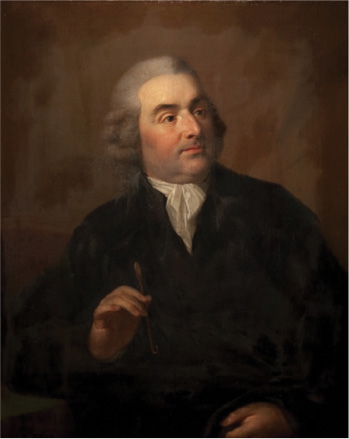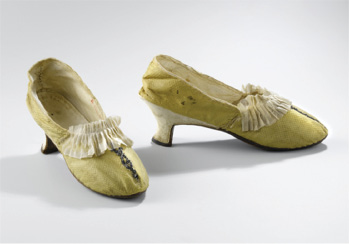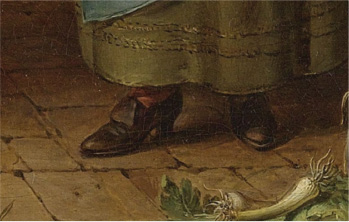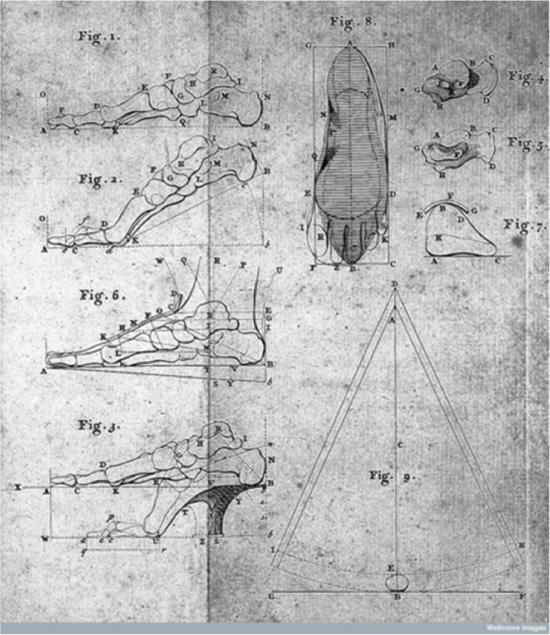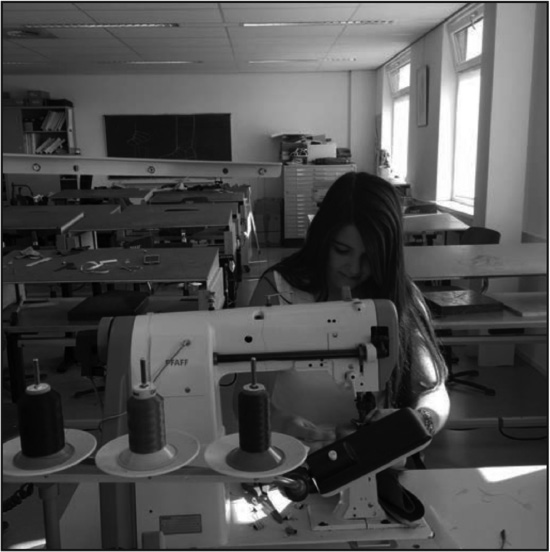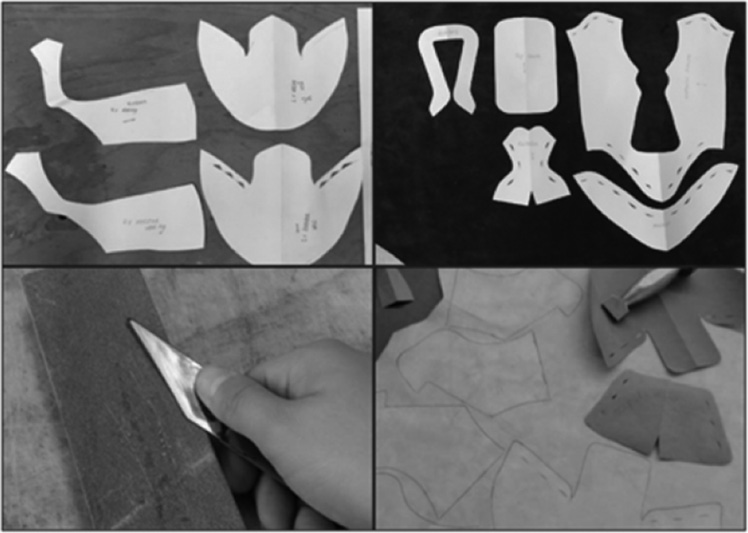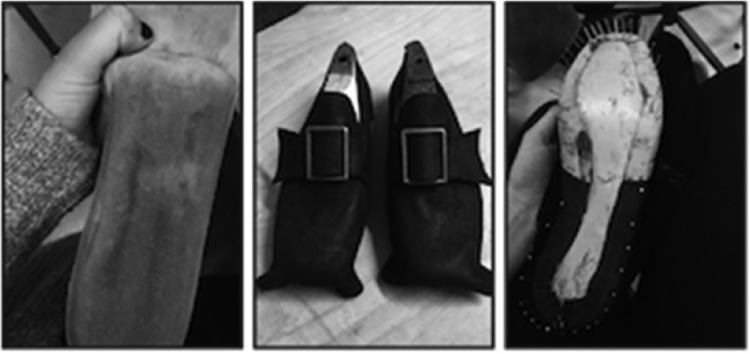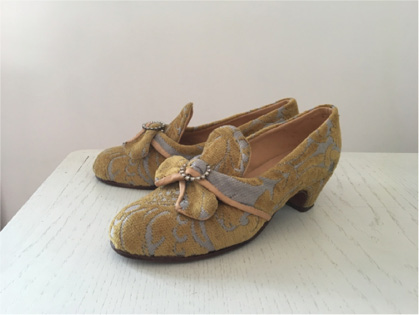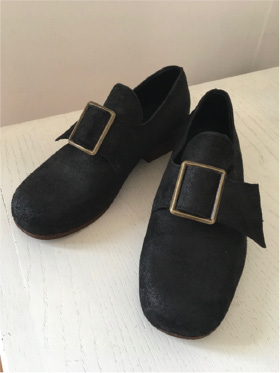ne sutor supra crepidam
cordonnier, borne-toi à la chaussure
Schuster, bleib bei deinem Leisten
schoenmaker, blijf bij je leest
let the cobbler stick to his last
As it appears, this proverb is rooted in Pliny’s story about the Greek painter Apelles. When a shoemaker told Apelles that he had depicted a sandal wrongly, Apelles adjusted his painting. However, when the cobbler subsequently criticized other details in the painting, Apelles told him to ‘stick to his last’. It appears from the examples above that this expression became proverbial in most European languages to indicate that people should only concern themselves with things they actually know something about.1 However, in 1779, Groningen professor of anatomy Petrus Camper definitely wandered a little from his last when he published his treatise on the best shoe (Verhandeling over Den Besten Schoen) in Jacob Voegen van Engelen’s edited volume ‘Cabinet of Medicine, Natural History, and Oeconomy’ (Genees- Natuur- en Huishoudkundig Kabinet), and turned the tables by telling shoemakers how to do their work.2 (fig. 1)
Johann Heinrich Wilhelm Tischbein, Petrus Camper, 1788. Groningen University Museum.
Camper gave his pamphlet a Latin motto: “Non multum abfuit, quin Sutrinum quoque inventum a Sapientibus diceret Posidonius”, or “Posidonius had almost declared that even shoemaking was an invention of the learned”, referring to Seneca’s critique on the philosopher Posidonius, who in his eyes overestimated the power of the intellect. In a way, Camper’s work was in turn a critique of Seneca, as he wrote the pamphlet as the result of a bet with his students that he could write a philosophical treatise about anything – even subjects that do not appear to be philosophical at first sight. Camper dealt with his topic – the influence of the fit and quality of a shoe on the health of the foot during the various stages of life – very seriously, in an age when inadequate footwear was widespread, caused much discomfort, and could even cripple the wearer.
Although the booklet initially did not seem to have much influence on practical shoemaking, it is now used as an introductory text for students of orthopaedic shoemaking at the Dutch Health Tech Academy, as Camper’s advice on the construction of shoes that preserve the health of the feet is still valid today. As a historian of art and science with a strong interest in reconstructive historical research, I wondered if Camper’s text on the ideal shoe could actually be used as a guideline for a historically informed reconstruction of a healthy and fashionable shoe – the kind of shoe Camper’s contemporaries might have liked.3
Together with advanced shoe-making students at the DHT academy, I constructed a man’s and a woman’s shoe that fit both Camper’s guidelines and 1780s fashions. Using Camper’s text and the construction process, I reflect on the cultural and academic context in which Camper wrote his pamphlet, and demonstrate that writing this text for Camper was a way of self-fashioning, while questioning a persistent hierarchy in which non-intellectual, mechanical arts such as shoemaking were situated at the bottom. Recent scholarship has convincingly shown that using dichotomous categories such as mind/hand, scholar/craftsman, and theory/practice when trying to understand early modern epistemic cultures is anachronistic.4 Yet scholars like Pamela O. Long and Paola Bertucci have also argued that on opposite ends of a vast and complicated, intertwined field of artisanal and intellectual knowledge and practices, there were still distinct spaces of theoretical learning and mechanical production throughout the early modern period.5 This research shows how persistent the idea of the cobbler as the ultimate unintellectual craftsman is in the historiography of theoretical and craft knowledge within the history of science.
In this article I show that the (re)construction of objects based on historical textual sources can give us insight in how such sources may have functioned in their original context and lead us to reflect critically on the development of their long-term reception history. Moreover, the (re)construction process of Camper’s ideal shoe shows that the ‘material turn’ in the history of science can also lead to a ‘historical turn’ in contemporary craft training. Finally, I suggest that the connection of Camper’s text to the early modern obsession with regimen has allowed it to retroactively become the theoretical foundation of a field that relied almost exclusively on practical, technical instruction and the development of material literacy until the early twentieth century.
The context of Camper’s treatise
Camper was definitely not the first medical man to refer to shoemaking in his work: already in the late fifteenth century, the lack of skill of surgeons was described in explicitly artisanal terms by a German doctor. Johannes Kirchheimer or de Ketham (1415–1470) wrote:
“like a shoemaker who makes everyone’s shoes on the same last, they [the surgeons] heal all wounds with the same plaster, through which, as is sadly reported, many people are left paralysed or crippled”.6
Similarly, in 1582, the Bolognese surgeon, physician and alchemist Leonardo Fioravanti (1517–88) in his treatise on surgery compared the surgeon to a shoemaker, and not favourably, when he wrote:
“…there is a big difference between the dead skin [of footwear] and the living [skin of the foot], it is not enough only to know how to bandage, spread ointments on, and dress wounds: but one needs to have scientiae, as I said above. And with God’s help, such that if I did not have scientiae and long experience, not only would I not treat [people] but also I would not reason well, for it is a great burden of conscience, the treating of people, not as if a shoemaker messes up an old boot or shoe.”7
However, we have no idea whether Camper knew these rather obscure works, and rather than just using shoemaking as an analogy to discuss surgical skills, he discussed the relevance of the craft for healthy feet. Camper, who corresponded with Denis Diderot, was positioning himself in the late eighteenth-century encyclopaedic fashion that intellectualized manual labour.8 Bart Ramakers has previously and convincingly argued that this text was part of Camper’s rhetoric and publication strategies to establish himself as a respected learned man.9 However, there is more to this text. I think Camper chose his topic strategically: the popular perception of the craft of shoemaking was that it was a dirty and low activity – something which is reflected in popular literature of the time. Between 1763 and 1802, at least ten different farces in which a shoemaker or cobbler was the main character circulated in print in the Low Counties.10 These plays show that shoemakers were generally portrayed as dumb, rough and uncouth, making the craft the pre-eminent candidate to elevate in a philosophical treatise. Somehow, this stereotyping of cobblers as the penultimate unlearned early modern artisans is very persistent – both Long and Bertucci use the shoemaker as example of an unintellectual, mechanically operating artisan.11
When Camper wrote his pamphlet, shoes could roughly be divided in two categories: functional, everyday shoes worn by common people and fashionable shoes worn by the upper classes. (figs. 2 and 3) Ironically, the everyday shoes worn by the lower and middle classes were often healthier for the feet than the fashionable footwear of the upper classes, as their shoes were simple, sturdy and practical. However, it was rare that shoes were fitted to the individual last of the wearer, and most shoemakers used the same, symmetrical last for both left and right shoes. As Camper pointed out, he had great trouble finding a shoemaker who was willing to make him fitted shoes – in London he found no one, in Paris only after a long search, in Amsterdam and Groningen it were only a couple of elderly shoemakers who listened to his arguments – only in The Hague he found one young man who made him excellent shoes.12
Fashionable women’s shoes, Dutch, ca. 1760 –ca. 1775. Goat leather and satin. Rijksmuseum, Amsterdam.
Practical everyday shoes. Detail of Willem Joseph Laquy, The Kitchen, oil on panel. ca. 1760 – ca. 1771. Rijksmuseum, Amsterdam.
Based on his experiences and his study of the anatomy and pathology of the foot, Camper’s seven most important recommendations for the creation of a healthy shoe were as follows:
- a good shoe is made to measure
- the ideal shoe is adjusted to the road surfaces of the city in which the shoe is worn
- when sizing the shoe, the shoemaker should keep in mind that the foot lengthens when walking
- the heel piece of the shoe should be placed in such a manner that the wearer’s centre of gravity rests exactly on it
- the ideal height of the heel depends on the purpose of the shoe
- the toe of the shoe has to point slightly upwards and the soles should not be entirely flat
- the exact shape of the shoe should depend on the shape, size, age, and occupation of the wearer
These recommendations clearly reflect late eighteenth-century ideas about health more generally, such as a certain environmentalism and the idea that walking can be a good way of exercising, thus confirming the importance of balanced rest and motion stemming from classical regimen.13 Yet although clearly rooted in contemporary health theory, Camper’s recommendations seemed to me also thoroughly practical.
Reconstructing Camper’s shoe
Notwithstanding Camper’s serious discussion of the ideal construction of healthy footwear, it has always been assumed that this was a theoretical discussion without practical application. (fig. 4) As his contemporary Immanuel Kant wrote in his Critique of Judgement: “Camper describes very precisely how the ideal shoe should be designed, but he certainly could not make one.”14 Kant used Camper’s treatise to distinguish art from science, skill from knowledge, and practice from theory. Was and is the division so strict indeed? Could a shoemaker derive useful information for their practice from this text? How valid were Camper’s insights about the perfect shoe for healthy feet in the twenty-first century? These questions took me to the three-year shoemaker’s training course at the Dutch Health Tech Academy in Utrecht, where I was enthusiastically welcomed by lecturer Liesl Swart and her interns Femke Nooijen en Djezz Rosie.
Illustration from Camper’s Verhandeling. Wellcome Images L0004215.
To my surprise, they already knew about Camper’s treatise: it is mentioned to students in their very first classes, when the history of shoemaking is discussed. However, they had never studied the work in depth. Our first step was to read and discuss Camper’s text together, and Femke and Djezz soon came to the conclusion that his guidelines for the construction of a healthy shoe, such as the height of the heel, the place of the clasps, sizing, and the form of the last and the nose of the shoe were still orthopedically correct. Subsequently, we talked about how we could use the text and other sources to make two pairs of healthy shoes – one for men, one for women – according to the guidelines envisioned by Camper. Since Camper complained that people cared more about fashionable than about healthy shoes, we wanted to know if it was possible to make healthy shoes that suited both Camper’s ideals and contemporary 1780s footwear fashion. Therefore, we studied historical shoes and depictions of shoes in paintings from the period, primarily from the digitized collections of the Rijksmuseum.
Based on these images, the shoemakers designed a man’s and a woman’s shoe, and chose materials that rather than being as historically accurate as possible would produce the kind of healthy shoe that Camper’s wealthy contemporaries might have liked. Reconstructions of historical objects and materials are used in a variety of fields, such as technical art history, musicology, history, sociology, anthropology, and archaeology, for a variety of reasons. Exactly how one goes about such a process – whether an existing, a lost, or rather an ideal object that never existed as such is (re)produced, whether all materials and techniques used have to be as historically accurate as possible, whether it is the process or the end result that matters most – depends strongly on the field and the purpose of the reconstruction. In our case, using the text as a guideline for practice and reflecting on the possible roles of the text had to result in a better understanding of the text and in two pairs of shoes that would convey the idea of a healthy late eighteenth-century shoe to a modern audience.
For me as a researcher, discussing Camper’s text with modern craftspeople and closely observing their making processes gave me insight in the relevance of Camper’s work for orthopaedics, but also, and perhaps more importantly, in how an essentially theoretical text, which was not primarily meant to inform craftspeople, can influence and function within practice anyway. Even if it did not influence his contemporaries’ practices, Camper’s text retroactively became a tool for the self-fashioning of twentieth- and twenty-first-century shoemakers. Observing Femke and Djezz working on the shoes made me wonder if Camper had done the same with the shoemakers he had visited to have his shoes made. If he did, it is even easier to see why he would have felt that he could only comment on the orthopaedic guidelines for healthy shoes, and only in general terms on the practices of the craftsperson. (figs. 5–7) The dexterity and manual skill required to make made-to-measure, high-quality shoes can only be developed over years of hands-on training. Although today’s shoe-making students do have richly illustrated text books, these are used as mnemonics rather than as manuals that are constantly consulted throughout the making process.
Femke at work. Photograph: Djezz Rozie.
Preparing the materials. Photograph: Femke Nooijen.
Construction of the men’s shoes. Photograph: Djezz Rosie.
For the young shoemakers on the other hand, fashion-loving young women who had very consciously chosen to learn a craft rather than enrol in continuing theoretical education, using Camper’s text as a guideline to construct ‘eighteenth-century shoes’ was a way of accessing the history of their own craft, and it helped them to see their skills in a new light. As one of them put it: “I never liked history much in school, but this I do find interesting.” Although we know that texts like Camper’s were not primarily meant to educate the craftsmen whose field they covered, our construction of his ideal shoe thus showed us that such texts can give us new insights in both our own valuation of craft, and in the reasons why crafts that had thus far had been perceived as purely utilitarian from the second half of the eighteenth century were linked to philosophical discourse. For Camper, writing this text was a way to assert himself – he used this text to place himself firmly in the tradition of the French philosophes and Encyclopédistes he so admired – but in a way he and his contemporaries also stressed the potential value of the skills of craftsmen in the preservation of health, thus indirectly elevating the status of the craftsman. Even over two hundred years later, this also helped the young shoemakers at the Academy to assert themselves as educated craftswomen who stand in a long tradition.
How Camper’s booklet retroactively became the foundation of shoemaker’s education
The Enlightenment ideal of the craftsperson as a knowledgeable maker who with his products could contribute to the healthy life of citizens that was reflected in Camper’s text, combined with the disappearance of what was left of the guild structure, would also influence the formalisation of vocational training in the nineteenth-century Netherlands. However, it was not until the early twentieth century, when interest in craft history surged, that Camper’s text was referred to in text books for shoemakers in training.15 This afterlife of the treatise is an aspect that warrants further research. The fact that the first craft school in the Netherlands was only established in 1861, and that a national law regulating continuing professional education was not introduced until 1919, might explain why Camper’s text appears to have raised little interest with cobblers initially, many of whom were barely literate when it was first published.16 Another reason that Camper’s text only retroactively became a foundational text for shoemakers in training might have been that his obsession with regimen fitted into the early twentieth-century fascination with creating a healthy body through diet, dress, and lifestyle.17 (figs. 8 and 9)
The end result: women’s shoes. Photograph: author.
The end result: men’s shoes. Photograph: author.
For now, one important question remains: would Camper’s contemporaries have liked our shoes? Would they have wanted to wear them? The answer is probably: some of them. Then as now, there would have been a segment of wealthy consumers who cared more about looks than quality or comfort, and who would have thought Camper’s shoes too sturdy and practical to be elegant and fashionable. However, as Giorgio Riello has pointed out, the body functioned, then as now, ‘as the primary site of personal values and attitudes and as the elementary expression of personal, collective, and social order.’18 The last decades of the eighteenth century saw ‘medical’ overtones in the European debate over fashion more generally, and health- and fashion-conscious consumers may well have been interested in having Camper’s ideal shoe made for them.
So even though Camper’s recommendations for making shoes that preserved the health of the feet were primarily theoretical and did not in any way help shoemakers to gain or develop the technical, practical skills they needed, reconstructing, or rather constructing, Camper’s ideal shoe gave us a deeper insight in both the social and medical contexts in which he wrote his text, the way in which it was perceived by his contemporaries and subsequent generations, and in late eighteenth-century ideas about health and craftsmanship.
The reconstruction of Camper’s ‘ideal shoe’ was on display at Groningen University Museum in the exhibition Gelukkig Gezond! Histories of healthy ageing (22 June 2017 to 31 January 2018).

